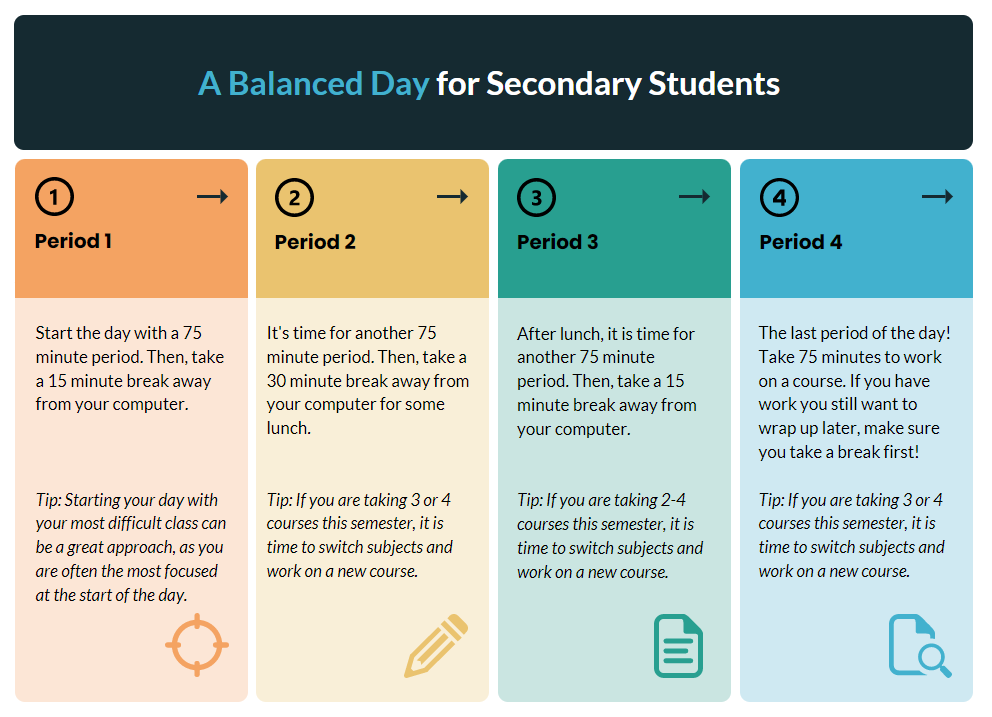 At Christian Virtual School we maintain an asynchronous environment for our secondary students. This means they can set their own schedules, create their own deadlines, and structure their days in a way that works best for them.
At Christian Virtual School we maintain an asynchronous environment for our secondary students. This means they can set their own schedules, create their own deadlines, and structure their days in a way that works best for them.
We feel like this allows for the most flexibility and best learning experience. Students are able to spend more or less time on courses depending on their confidence in the subject, while not sacrificing extra-curricular activities or family priorities.
To be successful in an online environment, however, structure is important. We encourage all of our students to put time into creating a routine for themselves, in a distraction-free environment, and to work with their teachers as they learn to set goals for themselves. To help our students in this process, we suggest starting by answering a few important questions:
- When do you want to have all of your courses complete by? A typical school year runs from September to the end of June, but students enrolled at CVS have up to 12 months to complete each of their courses. A student can choose the start and end dates of their school year.
- How many instructional days are available from your start date to your end date? For example, in a school year that runs from September to the end of June there are roughly 180 instructional days. Students should make sure not to include days like weekends, holidays, vacations, and time off, like a break in the spring, in this number.
- How many courses do you want to work on at once? Depending on how each student works best, they may choose to complete 1, 2, 3, or 4 courses at once. We do not suggest more than 4 at a time for our secondary students, but families can always meet with our Guidance team to discuss alternative arrangements. The number of courses a student takes at once will determine if they are on an octomestered (8 semesters, 1 course each), quadmestered (4 semesters, 2 courses each), trimestered (3 semesters, 2-3 courses each), or semestered (2 semesters, 4 courses each) timetable.
- How long is each one of your semesters? Taking the number of instructional days (question 2) divided by the number of semesters (question 3) will give students this answer. This forms the basis of their yearly calendar.
These questions will help students set up a general calendar for the year. Then, we suggest they begin to set milestones within that calendar. Working backwards from when they would like to be finished each course, they should answer:
- Is there a final project or exam in this course? If so, students should ask themselves how long they want to spend at the end of the course studying/completing this portion. Often, and especially in Grade 9, students are nervous before taking their first exam. Blocking off time at the end of their semester, possibly even a week or two depending on their timetable (a semestered approach allows for more time to study than an octomestered approach), is a great step in reducing anxiety and ensuring students have the time they need to prepare for their final assessment.
- How many units are in the course? By using the number of units in a course as milestones, a student can divide the remaining time in their semester by the number of units in their course and use that as a rough schedule of completion. There are two reports completed by the teacher in each course. The midterm report and the final report. The midterm report is issued when the student completes half of the units in a course. Students should aim for this to be about half-way through their semester.
The next step that we suggest is to set up a daily routine. Each secondary course is designed to take approximately 110 hours of instructional time. This varies per student, but a general schedule that will allow students to achieve this is outlined below. If students are on a schedule that has significantly more or less than 180 instructional days, they may need to adjust the period length from what is described here.

If at any time our students have questions about setting up a schedule, we are here to help. They can reach out to their teacher, the Guidance team, or the Administration team for assistance. Creating a schedule and setting goals is a learning process! Interested in learning more about the asynchronous environment? Book a tour with us today.




